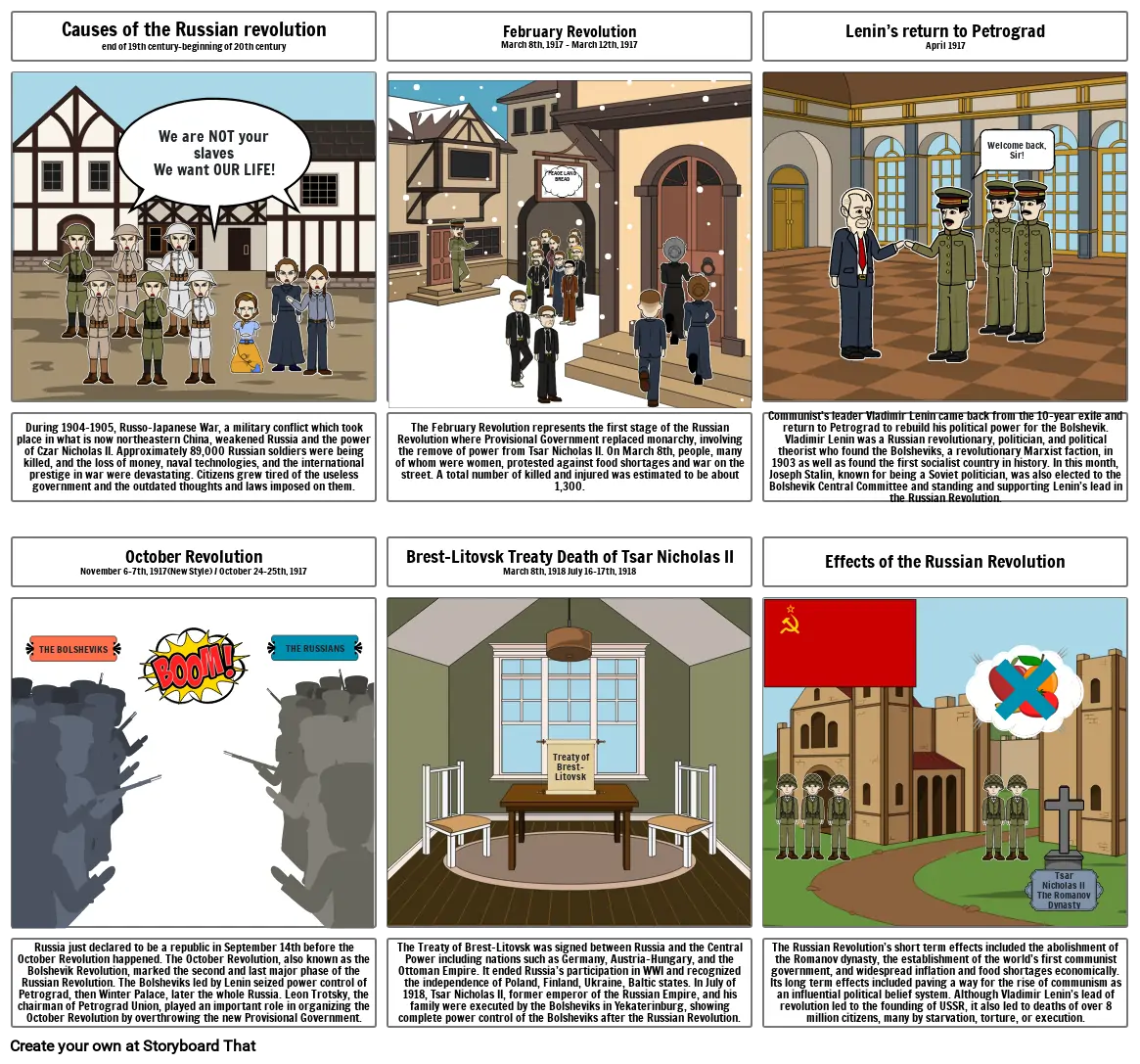Russian Revolution Timeline

Süžeeskeem Tekst
- Causes of the Russian revolutionend of 19th century-beginning of 20th century
- We are NOT your slavesWe want OUR LIFE!
- February RevolutionMarch 8th, 1917 - March 12th, 1917
- PEACE LAND BREAD
- Lenin’s return to PetrogradApril 1917
- Welcome back, Sir!
- During 1904-1905, Russo-Japanese War, a military conflict which took place in what is now northeastern China, weakened Russia and the power of Czar Nicholas II. Approximately 89,000 Russian soldiers were being killed, and the loss of money, naval technologies, and the international prestige in war were devastating. Citizens grew tired of the useless government and the outdated thoughts and laws imposed on them.
- October RevolutionNovember 6-7th, 1917(New Style) / October 24-25th, 1917
- THE BOLSHEVIKS
- THE RUSSIANS
- The February Revolution represents the first stage of the Russian Revolution where Provisional Government replaced monarchy, involving the remove of power from Tsar Nicholas II. On March 8th, people, many of whom were women, protested against food shortages and war on the street. A total number of killed and injured was estimated to be about 1,300.
- Brest-Litovsk Treaty Death of Tsar Nicholas IIMarch 8th, 1918 July 16-17th, 1918
- Communist’s leader Vladimir Lenin came back from the 10-year exile and return to Petrograd to rebuild his political power for the Bolshevik. Vladimir Lenin was a Russian revolutionary, politician, and political theorist who found the Bolsheviks, a revolutionary Marxist faction, in 1903 as well as found the first socialist country in history. In this month, Joseph Stalin, known for being a Soviet politician, was also elected to the Bolshevik Central Committee and standing and supporting Lenin’s lead in the Russian Revolution.
- Effects of the Russian Revolution
- Russia just declared to be a republic in September 14th before the October Revolution happened. The October Revolution, also known as the Bolshevik Revolution, marked the second and last major phase of the Russian Revolution. The Bolsheviks led by Lenin seized power control of Petrograd, then Winter Palace, later the whole Russia. Leon Trotsky, the chairman of Petrograd Union, played an important role in organizing the October Revolution by overthrowing the new Provisional Government.
- The Treaty of Brest-Litovsk was signed between Russia and the Central Power including nations such as Germany, Austria-Hungary, and the Ottoman Empire. It ended Russia’s participation in WWI and recognized the independence of Poland, Finland, Ukraine, Baltic states. In July of 1918, Tsar Nicholas II, former emperor of the Russian Empire, and his family were executed by the Bolsheviks in Yekaterinburg, showing complete power control of the Bolsheviks after the Russian Revolution.
- Treaty of Brest-Litovsk
- The Russian Revolution’s short term effects included the abolishment of the Romanov dynasty, the establishment of the world’s first communist government, and widespread inflation and food shortages economically. Its long term effects included paving a way for the rise of communism as an influential political belief system. Although Vladimir Lenin’s lead of revolution led to the founding of USSR, it also led to deaths of over 8 million citizens, many by starvation, torture, or execution.
- Tsar Nicholas IIThe Romanov Dynasty
Loodud üle 30 miljoni süžeeskeemi
Proovimiseks Pole Vaja Allalaadimist, Krediitkaarti ega Sisselogimist!

